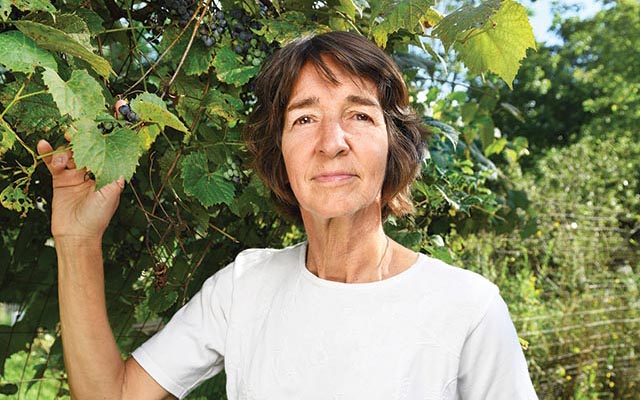Carrie Koplinka-Loehr ’80 enlightens, in her new book, on how climate will change our menu.
It used to be once every few years that we’d hear news of a late frost damaging a cherry crop, a new pest moving into an orchard, or a freak flood wiping out cornfields. But as climate change transforms these events from bad luck to a new normal, the people who grow and harvest food — and the people eating it — are going to have to accept some changes. That’s the premise of Our Changing Menu (Cornell University Press, 2021) by Carrie Koplinka-Loehr ’80. Alongside coauthors Michael Hoffmann and Danielle Eiseman, she takes us through a menu of our favorite foods and beverages, tackling how climate change will affect ingredients from olive oil to dairy, coffee to chocolate, and more — as well as how our choices affect how much the climate is changing in the first place.
As humans continue to pump greenhouse gases like carbon dioxide and methane into the atmosphere, it thickens the cozy blanket that keeps our planet warm. This warming not only raises the average temperature, but also alters weather patterns we, and our crops, are used to. Dry areas are getting drier, and wet areas are getting wetter. And when rainfall does come, it’s often in fewer, harder bursts. Koplinka-Loehr and her coauthors scoured more than 700 research studies and other references, and interviewed experts from universities, farms, orchards, and more to learn what changes the climate has already brought to our food system and, perhaps, what’s yet to come.
The picture is extreme but hopeful. For instance, many of the crops on which our favorite alcoholic beverages rely are at risk, but only if the production system doesn’t adapt. Researchers the world over are developing heat- and drought-resistant crop varieties that can save our barley and hops for our beer. Tequila makers can switch to commercially grown, wild agave, which better tolerates hot and dry conditions. And as vineyards lose their historical growing conditions (or worse, are flooded by rising seas), others will pop up when new areas become ideal for grapes — connoisseurs of wines from California, Italy, and France may have to accept bottles from Washington, New Zealand, or northern Europe.
Climate doesn’t just affect our food; our food choices affect our climate. The biggest impact we can have, the authors say, is through how much beef we consume. Per unit of protein, beef produces 50 times the greenhouse gases as wheat and six times more than pork.
“Eating beef is a huge driver for climate change, not just the methane the cows create as they digest their food, but also transportation and the cutting of the rainforests; the whole cycle of beef production is very energy intensive,” Koplinka-Loehr says. Especially in places like North America where protein options are plentiful, people could make smarter choices. Even reducing beef consumption by a little — treating it as a delicacy instead of a daily staple — would help.
Koplinka-Loehr always knew she wanted to combine science and writing to help the environment, even before she arrived at Colgate. It was there, she says, she found her niche — and became a vegetarian. She also started an ecology house on the edge of campus. “There were ways I was able to combine my love of the environment and of writing,” says the English major who also studied biology and earth sciences. “And I think that held me in pretty good stead.”
During college and after graduation, she worked in a water quality research lab, with kids at an environmental education camp, and for the nonprofit Atlantic Center for the Environment before going back for a master’s in science education from Cornell University.
After a career in communications, Koplinka-Loehr switched to book writing. “The book was a great way for me to feel, especially during the pandemic, that I was contributing to a larger whole,” she says. “Writing the book felt purposeful; it’s something greater than myself.”

